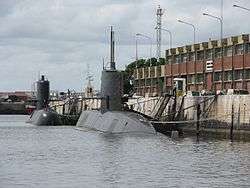List of submarines of Submarine Force Command
| Comando de la Fuerza de Submarinos Argentine Submarine Force | |
|---|---|
|
TR1700s at Mar del Plata naval base (2007) | |
| Active | 1927 – present |
| Country |
|
| Branch |
|
| Type | submarines |
| Size | 3 |
| Part of |
Navy Ministry of Defense |
| Anniversaries | September 3 |
| Engagements |
Revolucion Libertadora Falklands War |
| Commanders | |
| Commander-in-Chief | President of the Republic |
| Chief of Staff of the Navy | Admiral |
| Chief of COFS | Capitán de Navío |
The Argentine Submarine Force (Spanish: Comando de la Fuerza de Submarinos, COFS) is the submarine service branch of the Argentine Navy. Argentine submarines have traditionally been named after the provinces of the Republic whose name begins with the letter 'S'; they are home based at Mar del Plata naval base. COFS members have the same rank insignia and titles as the rest of the Navy. As of 2010, the elite group Agrupación de Buzos Tácticos is under the direct command of the submarine force; two TR-1700 and one Type 209 submarines are in service. Two small surface vessels, ARA Punta Mogotes (P-65) and ARA Luisito (Q-51), are also part of the COFS and used in the training role.
Like the rest of the Argentine armed services the force is struggling to maintain its readiness in the absence of funds for maintenance and training. All three boats have maintenance difficulties and between them spent just 19 hours submerged in 2012.[1]
It is currently composed of three submarines: ARA Salta (S-31), ARA Santa Cruz (S-41) and ARA San Juan (S-42).
History
In 1917 the Navy sent students to the United States to begin training courses at the Naval Submarine Base New London. Lieutenants Francis Lajous, Osvaldo Repeto, Eduardo Ceballos and Vicente Ferrer served in the US Navy during the First World War.
First generation
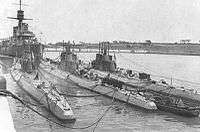
In 1927 the Argentine Navy signed a contract with the Italian shipyard Franco Tosi of Taranto in order to build the service's first three ships. The units arrived in Buenos Aires on April 7, 1933 and transferred to Mar del Plata on September 3, which became the Anniversary Day for the newly created Submarine Force. The Tarantinos, as they were known, served between 1933 and 1960 when the last one, Santa Fe (S-1), was retired after taking over a thousand dives. In 1938, the crew of the Santa Fe had been awarded a civilian medal after assisting a local fishing boat that was in distress off Cabo Corrientes.[2] Santiago del Estero (S-2) established (at the time) an immersion record for a submarine in the South Atlantic (114 metres).[3] Santiago del Estero took part in the blockade of the Rio de la Plata during the 1955 Revolución Libertadora, where she fought off a strike package of Gloster Meteor fighters loyal to president Juan Domingo Peron.[4]
- ARA Santa Fe (S-1)
- ARA Santiago del Estero (S-2)
- ARA Salta (S-3)
Second generation
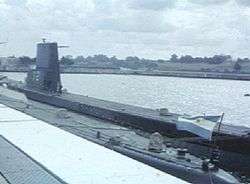
In April 1960 the US Navy agreed to transfer two Balao-class submarine units on loan under the Military Assistance Program. They departed from San Francisco, California on September 23 of the same year and arrived in Mar del Plata on November 30. These ships participated in numerous exercises during their career including UNITAS, CAIMAN, SAYONARA and CAIO DULIO. The conning towers of both submarines were locally upgraded to improve hydrodynamics.[5] Some years ago, Argentinian officials disclosed that a group of tactical divers had carried out an incursion on the Falkland Islands on board the Santiago del Estero (S-12) in October 1966.[6] The submarines went back to the United States for mid-life repairs and were finally retired in 1971.
Third generation
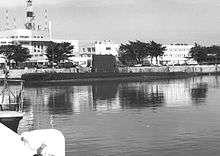
In 1971 the US Navy transferred further units in order to replace the previous generation. Two GUPPY-type submarines were an interim measure until new submarines being built in Europe became available. Santiago del Estero was retired by September 1981 but Santa Fe (S-21) would take part in the 1982 Falklands War. She landed a team of Buzos Tácticos (tactical divers) on the initial amphibious assault and weeks later, after a successful resupply mission, was spotted on the surface. She was attacked and disabled off Grytviken, South Georgia; the submarine was scuttled in deep waters by the British some years after the war ended.
Fourth generation

In 1969 a contract was signed in West Germany for two Type 209 submarines. The ships were of the 56 metres/1100 ton sub-type; they were built in parts by Howaldtswerke at Kiel and delivered to Tandanor shipyard in Buenos Aires where final assembly was completed in 1973. The vessels were commissioned in 1974, but only San Luis (S-32) was in service during the 1982 Falklands War. She reported two encounters with Royal Navy ships but without scoring hits due to problems with her torpedo's firing system. The threat posed by the San Luis, however, forced the Royal Navy to give up recovery efforts of two Sea King helicopters which had ditched at sea on 12 May and 18 May 1982 respectively. Both aircraft were eventually destroyed by naval gunfire.[7][8] She also tied up a considerable number of British naval assets deployed to counter her presence.[9] There was an attempt to deploy the Salta to the Falklands area at the end of May, but excessive noise and problems with the torpedo firing system similar to those found on San Luis prevented her operational use.[10] San Luis was struck from the Navy in 1997 after an incomplete overhaul, whilst Salta (S-31) was still in service as of 2013.
Fifth generation
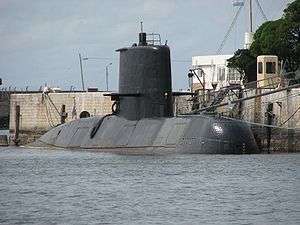
As part of a major fleet renovation plan which included the MEKO frigates classes, a contract was signed in 1977 with West Germany's Nordseewerke for six TR-1700 class submarines, the last four of them to be built in Argentina. The Argentine Navy sponsored the development of the CAREM nuclear reactor to be installed on these submarines,[11] but for political reasons the whole program was cancelled and only the two German units were delivered. These ships are the largest submarines built in Germany since World War II and are among the fastest diesel-electric submarines in the world.[12]
References
- History section of official website
- Submarinos Argentinos at soldadosdigital.com
- ↑ "Argentine navy short on spares and resources for training and maintenance". MercoPress. 22 November 2012.
- ↑ Paz, R., Tamburini, F. and Iñurrieta, V. (2009). Los Tarantinos: Argentina 1933- 1960. Historia de Submarinos. ElSnorkel, p. 151. ISBN 987-25327-0-2 (Spanish)
- ↑ Paz, Tamburini and Iñurrieta, p. 150
- ↑ Paz, Tamburini and Iñurrieta, pp. 150-151
- ↑ Historia y Arqueologia Marítima: Submarinos Clase "Balao" (Spanish)
- ↑ Malvinas: Los Secretos de la Guerra Clarín, 31 March 1996 (Spanish)
- ↑ UK Military Aircraft Losses - 1982 Wolverhampton Aviation Group
- ↑ Howard, L. Burrow, M and Myall, E. (2011). Fleet Air Arm Helicopters since 1943. Staplefield, p. 239. ISBN 978-0-85130-304-8
- ↑ Submarine Operations during the Falklands War - Lt Cdr Steven R. Harper USN
- ↑ El Secreto del ARA Salta by Jorge Rafael Bóveda (Spanish)
- ↑ El Carem fue diseñado a partir de la idea de técnicos navales para incluir un reactor de esas características en los submarinos comprados a Alemania en la década del 70 (Spanish)
- ↑ Miller, David (2002). The Illustrated Directory of Submarines. Zenith Press. p. 480. ISBN 0-7603-1345-8.
External links
| Wikimedia Commons has media related to Submarines of Argentina. |
- (Spanish) History of Submarine force at Official site
- Official Museum
- (Spanish) Fuerza de Submarinos de la Armada Argentina at deyseg.com.ar
- (Spanish) Argentine submarines at elsnorkel.com
